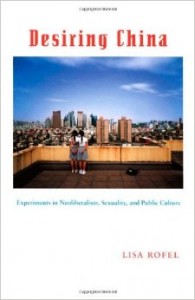 Desiring China: Experiments in Neoliberalism, Sexuality and Public Culture
Desiring China: Experiments in Neoliberalism, Sexuality and Public Culture
by Lisa Rofel
Duke University Press. 252 pages, $21.95
CHINA’S VERTIGINOUS RISE as a global economic player is being watched with fascination by those who once dismissed China as a moribund Communist state. This change in perception has triggered an urgent need in the West for the production of knowledge about the country. Over fifty scholarly books have been published since 1990, and several more are forthcoming. Lisa Rofel’s collection of essays entitled Desiring China is the latest offering to a world eager to make sense of this “inscrutable” nation.
Rofel explores this epic shift by dipping an analytical finger into six aspects of contemporary Chinese society: a popular soap opera and the public discussion it generated; a museum dedicated to Chinese women; the formation of gay identities; the culture of cosmopolitanism; closely watched legal cases; and the negotiations leading up to China’s entry into the World Trade Organization (WTO).
Two of her excursions—public response to the soap opera (whose name is translated as “Yearnings”) and the women’s museum—reveal the tension between the ancien ideal of womanhood and the new model. This tension is even more clearly visible in the case of the emerging non-heterosexual identities in China today. Rofel identifies the complex conflicts involved in the identity formation of, for instance, a city-dwelling gay Chinese man who wants to partake of the “global gay” identity but still find a way to preserve his “Chineseness.” He wants to belong to a Chinese gay brotherhood but dissociates himself from rural gay men in the provinces. What is apparent is that homosexuality is now more visible in China than it has been since the Communist Revolution of 1949. Rofel cites two legal cases whose verdicts were interpreted as positive outcomes by Chinese gay rights activists.
Reading Rofel’s analysis of Chinese gay identity formation, one is struck by a peculiar omission. When she talks about the women’s museum, she evokes ancient Chinese history. While discussing China’s entry into the WTO, she places this event in the history of international trade, which takes her back to the 13th century. And yet, she makes no mention of the history of homosexuality or its presence in ancient and medieval China when discussing today’s gay identities. It is jarring to find no mention of Bret Hinsch’s widely read history of Chinese homosexuality in Passions of the Cut Sleeve (1990). She claims that gay Chinese identity is being forged in the white heat of the influx of Western gays and lesbians into China, on the one hand, and a state policy of encouraging personal desires, on the other. This claim is seriously undermined by her omission of the cultural significance of terms such as “cut sleeve” and “bitten peach”—though she does discuss at some length the appropriation of the word “tongzhi” (“comrade”) by GLBT people today.
Rofel’s book broadens the context for understanding the emergence of gay identities in China by seeing it as symptomatic of China’s greater engagement with the world and the shift to a consumer economy. The omission of any historical treatment of these identities is a flaw, but the book’s main purpose is to generate knowledge about what’s happening in China, still a relatively closed society, at a time when the West’s need to know has never been greater.
____________________________________________________________________
Niladri Chatterjee is a senior lecturer in the Dept. of English at the University of Kalyani, India.





